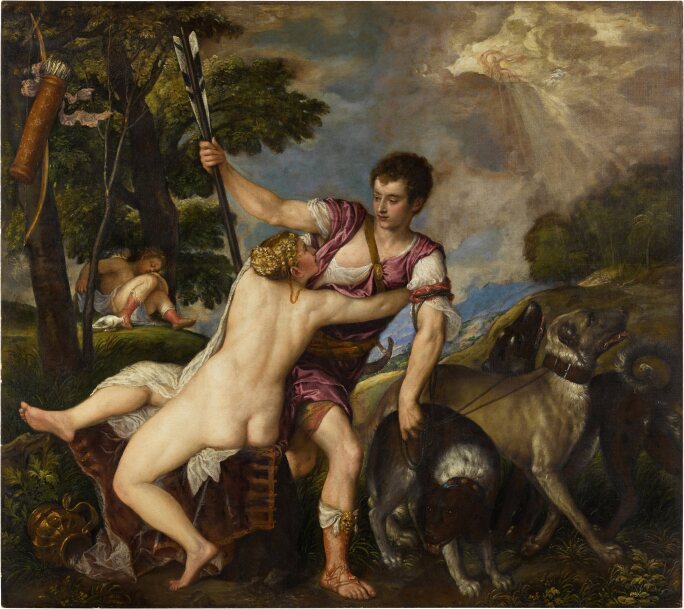S otheby’s is delighted to announce that one of the finest versions of Titian’s beloved subject Venus and Adonis, will come to auction on 7 December 2022. After remaining out of public view for most of the 19th and 20th centuries, this rendition will lead the December Old Masters sale, becoming the most important painting by the artist to be offered at auction this century, with an estimate of £8-12 million.
The classical love story between goddess and mortal man is one that Titian addressed many times, from the 1520s onward. As the story told in Ovid’s Metamorphoses goes, Venus, the goddess of love and beauty, fell in love with Adonis, a handsome young hunter, after she was accidentally hit by one of Cupid’s arrows. Besotted, Venus cautioned Adonis against hunting more dangerous animals, wanting to keep him safe from harm. But the young man ignored her warning and embarked on a hunt with his hounds, only to be fatally gored by a wild boar. Although Venus heard his cries for help and rode from Olympus in her chariot to his aid, she was too late to save him.
Portraying the timeless motif of lovers parting, depicting Venus begging Adonis not to go on the hunt, this particular version is one of about a dozen paintings of this subject by Titian that survive today. It stands out as being the most fully-elaborate interpretations of Ovid’s narrative, the only extant example to include both the goddess in the sky and the scene of Adonis’ cruel fate in the background.
“This is one of Titian’s most famous compositions that shows his genius for sensuous subjects in rich landscape settings,” says Cecilia Treves, Head of Research for Old Master Paintings, Sotheby’s London. “It is Titian’s most complete interpretation of Venus and Adonis’ story. It is early morning; he is about to leave her to go hunting; she tries to warn him against the dangers but he sets off regardless and is soon fatally wounded. Our eye is drawn to the sunlit clearing where the tragic ending takes place.”
A 2015 technical examination of the painting established a broad consensus among scholars that this is a work conceived and developed by Titian himself, rather than his workshop alone. As George Gordon, Co-chairman, Old Master Paintings Worldwide, Sotheby’s Worldwide, explains: “One of the very finest of Titian’s renditions of this subject, it is only recent research, made possible by its reemergence last year, that has revealed the full extent of the artist’s hand in the execution of this painting, surely one of the finest works by Titian to appear on the market this century. The offering of a painting of extreme rarity by one of the greats of the Renaissance is a once in a generation opportunity.”
This version belonged to Prince Eugene of Savoy (1663–1736), the great general and statesman of imperial Austria. It was added to his spectacular art collection, which hung in the picture gallery of the Upper Belvedere, his palace in Vienna. A clear timeline of provenance has been established from the early 18th century to the present day; past owners include Benjamin West (1738–1820), President of the Royal Academy and King George III’s official history painter.
The most celebrated rendition of the composition now hangs in the collection of the Museo Nacional del Prado, Madrid, and was originally painted for Philip of Habsburg, later King Philip II of Spain (1527–1598) as part of a series of six mythological paintings, known as poesie, or ‘poem paintings’. The present work relates to the painting at the Prado and to another version of Venus and Adonis at the Getty Museum, Los Angeles. The poesie are among the greatest achievements of Titian’s career.
Titian’s Venus and Adonis will be on view at:
Sotheby’s New York, 4–17 November
Sotheby’s Hong Kong 23–27 November
Sotheby’s London, 2–7 December


